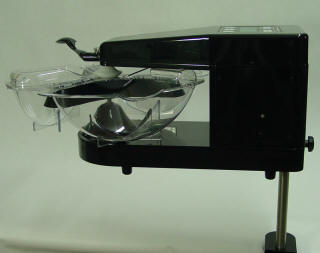Mealtime Partners, Inc.
Specializing in Assistive Dining and Drinking Equipment
May 2021 Independent Eating and Drinking Newsletter

|
May Topics:
|
||
|
Mealtime Partners Home Page Send a Comment or Suggestion |
|||
| Subscribe to Newsletters, or Unsubscribe from Newsletters |
Introducing the Adaptive Switch Mounting Lap Tray
Periodically Mealtime Partners introduces a new product to their existing line of assistive equipment. Typically the new item has been used extensively by our staff to meet the needs of clients but has been a “custom” item. After using the product repeatedly, if the company feels that it is of use to enough people, it will be added to our product line. This newsletter article is introducing the Adaptive Switch Mounting Lap Tray (Part Number: 6580).
Frequently we find that our users prefer to activate adaptive switches with their hands rather than other body parts, even when their hands don’t function as well as their feet, elbows, etc. Positioning the switches for reliable hand operation can be a challenge. We have found that a Lap Tray resting in someone’s lap makes a good foundation for switch mounting.
The surface of our Lap Tray is covered with Velcro allowing the switches to be located anywhere on the surface, additionally they can be moved, quickly and easily, if they need to be repositioned. The Velcro makes a comfortable resting place for the user’s hand or hands. Cables for the Adaptive Switches can be slotted through the handle at the top of the Lap Tray and held in place with a Velcro strap to keep them organized and relieve any strain that may be placed on them.
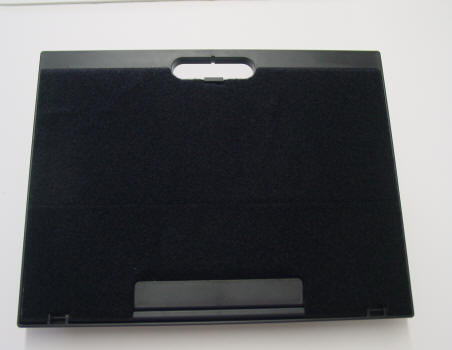 |
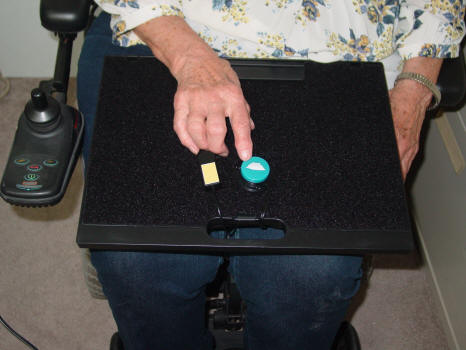 |
| Figure 1: The Adaptive Switch Mounting
Lap Tray top view |
Figure 2: Spec Switch & Micro Light
Switch Being Used on Lap Tray |
The Lap Tray provides a flat surface for switch mounting which meets the needs of a number of users; but for some people the surface needs to be elevated for them to be able to produce enough force to activate a switch with their fingers or hand. The top of the Lap Tray can be opened and supported in a wedge position as shown in Figure 3. The angle at which the tray is positioned is adjustable. Six options are available as shown in Figure 4.
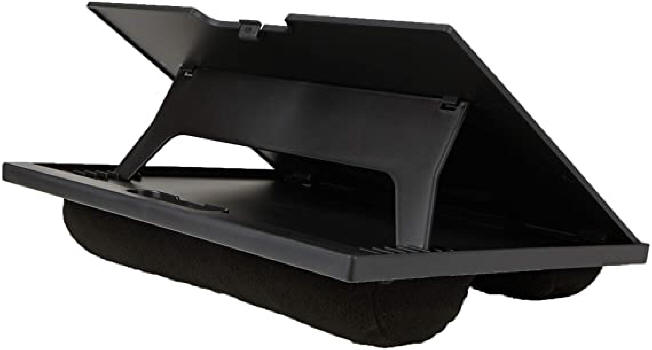 |
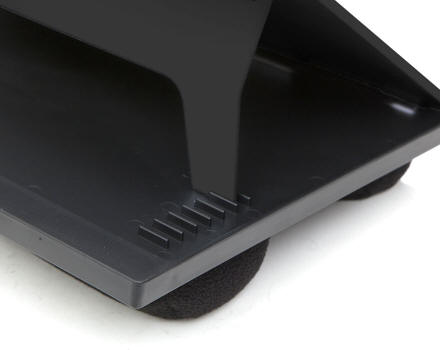 |
| Figure 3: Lap Tray with the Top Elevated | Figure 4: Lap Tray Elevation Adjustment |
Two bean bag cushions hold the Lap Tray in place on the user’s lap (as shown in Figures 3 and 4, above). Most users do not have any problems with the Lap Tray staying in place. However, if someone does find the Lap Tray slips off of their lap or changes position, it can be attached to the wheelchair by the Velcro strap that is provided with it (not pictured). The strap is attached to the underside of the Lap Tray between the two bean bag cushions. It then extends out from the Lap Tray and is attached to Velcro strips that are mounted on the sides of the wheelchair (provided with the Lap Tray).
The Lap Tray has a one-inch deep flip-up lip near the front edge which can support a Telephone or Tablet on the Lap Tray.
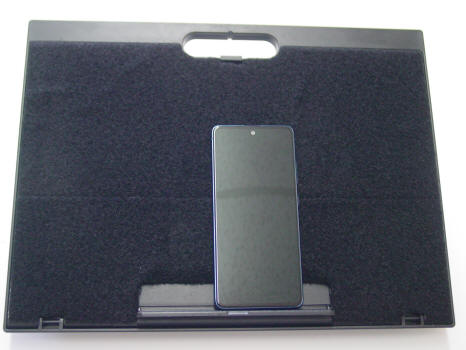 |
| Figure 5: Telephone held by flip-up Lip |
Click here for additional information, or to purchase the Adaptive Switch Mounting Lap Tray.
|
Assistive Dining at its Very Best The Mealtime Partner Dining System provides the means to eat independently for those who are unable to feed themselves in the traditional way. Because of its flexible design it can be configured to meet the needs of almost any user and will allow a relaxed, enjoyable meal that is under the control of the person eating. They are free to take a bite of food when they want, and to pause between bites for as long as they choose. Thus they are empowered to have a traditional mealtime and will never be hurried. Because the Mealtime Partner has three different mounting systems, as well as it being placed directly on a table for use, it can be positioned to meet the need of a diverse range of users. The Support Arm allows the spoon to be positioned to deliver food very close to the user’s lips. A small forward movement of the head can access the food on the spoon to be eaten. The Support Arm is suitable for individuals who have very limited extremity control because it can be fine tuned to the necessary position to provide access for them. The Mounting Shafts provide comfortable positioning of the Mealtime Partner for those who sit close to a table but are unable to put their knees under the table because they are restricted by their wheelchair or for any other reason. The Shafts allow the device to pivot away from the table to allow easy access for users. Shafts come in five different heights. |
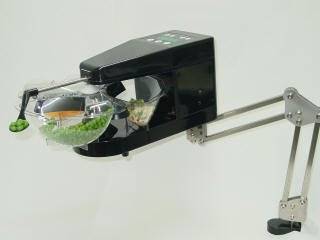 The Mealtime Partner Assistive Dining Device Mounted on the Support Arm
The Mealtime Partner Mounted on a 8-Inch Shaft |
|
For those users who are able to sit at a table with their knees
under it to eat, the Mealtime Partner can be mounted on legs.
The legs position the device at the appropriate height for each
user. Legs are supplied in three different heights. For additional information, please call us at 800-996-8607 or email us at info@mealtimepartners.com. |
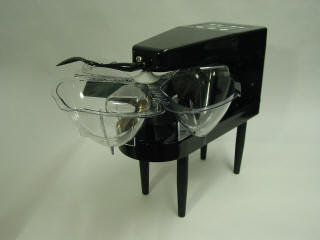
|
| The Mealtime Partner Mounted on 6-Inch Legs | |
| The Mealtime Partner Assistive Dining Device is available directly from Mealtime Partners, Inc. or Select Dealers. | |
In many of the articles in the Mealtime Partners Newsletters, caregivers who feed other people are encouraged to provide small bites of food and sips of liquid, rather than large bites and gulps of liquid. This article will try to shed some light on the “technical” reasons for these recommendations.
The processes of eating and drinking are two of the most basic human functions and almost everybody eats and drinks by mouth. The process of eating and swallowing, or deglutination, involves the interaction and coordination of many muscles and nerves to permit food to be transported from the mouth to the stomach, safely. Yet the vast majority of us eats and drinks without difficulty, almost automatically. We might choke on a very rare occasion, especially when we hurry or are distracted, but as a whole, meals, drinks, and snacks are given little attention beyond what is being consumed. And, when we do choke, we cough vigorously and dislodge whatever went down “the wrong way”, and are back to normal in just a few minutes.
Choking and aspiration occurs when the interplay between the respiratory system and the digestive system does not coordinate properly. The definition of choking is an object is in the airway. Partial or complete obstruction of the airway can be due to a foreign body (e.g., food, a bead, toy, etc.) entering it. When an object blocks the airway there is a sudden onset of respiratory distress with coughing. If the object is not removed the person will be unable to breathe. Uncorrected choking can be very serious and result in death when solids or liquids that should be swallowed into the stomach are instead breathed into the respiratory system and penetrates below the true vocal cords, or when substances from the outside environment are accidentally breathed into the lungs. Aspiration can result in aspiration pneumonia (an infection in the lungs) and is also very serious.
Obviously, all of us breathe ongoingly. Breathing continues while we chew a mouthful of food, just as we do when we are not eating or drinking. However, when we swallow, whether it is a “dry swallow” (only saliva), or a swallow to process food or liquid, our breathing must stop while we swallow. This is known as an apneic event. The period that breathing stops (the apneic period) varies in length considerably depending upon both the individual and the texture of the food or liquid being swallowed. We all follow a respiratory pattern even though the pattern differs from person to person. The majority of people chew and form a bolus; when the bolus is moved to the back of the mouth, they exhale (breathe out), stop breathing (apneic event), swallow, and then inhale. Some people inhale prior to the apneic event and exhale once it is over. The volume of the bolus being swallowed will impact the organization of this respiratory pattern .
Eating starts before food reaches the mouth when saliva is produced in anticipation of eating. The body position that the person is in while they eat greatly impacts their function when food is received. Once food enters the mouth, its texture affects how it is handled. For example, a cracker will need to be broken into very small particles by the teeth and the particles will be mixed with a significant amount of saliva as they are moved around the mouth by movement of the tongue and jaw to form a ball, or bolus, before it is swallowed. Yet a bite of soft food, like pudding, needs little or no chewing but only needs to be formed into an appropriate sized bolus and swallowed.
Lazareck and Moussavi1 describe normal swallowing as: “involving intricate control and coordination of three swallowing phases, commonly referred to as oral, pharyngeal, and esophageal”. The oral phase is when food is in the mouth and being chewed and mixed with saliva; the pharyngeal phase is when a bolus is formed in the mouth and is passed to the back of the mouth to the epiglottis (the flap of cartilage that is attached to the root of the tongue and keeps food/liquid from going down the windpipe); and the esophageal phase which is when the bolus enters the esophagus (the tube that connects the throat with the stomach).
Many studies have been conducted over the past several decades to gain a greater understanding of the swallow function and its interaction with respiratory function. Also, studies have evaluated changes in swallow function that occur when both different volumes of food or liquid are consumed, and when they are swallowed at a different pace2&3. However, for those who feed individuals who are unable to self-feed, there is little in the literature to guide them as to when to provide each bite of food or a drink. It is difficult for even a very observant feeding partner to see each time the person being fed, swallows. Even more difficult, is to know whether they will require additional swallows to clear their mouth after a single bite of food. Compounding this problem is the fact that meals are time consuming and most people who feed someone else have other people to feed, or other chores to attend to. This time constraint encourages feeding someone quickly. If the person has not cleared their mouth of food prior to receiving the next spoonful of food, they tend to hurry to clear their mouth, and in doing so they reduce the number of chews per bite of food. As a result, the size of the particles of food that make up the bolus are larger than those making up a bolus of well chewed bites. This process creates an environment that can promote choking or aspiration.
The same risk occurs when liquid is provided if the person is required to drink quickly. When drinking, if swallow after swallow occurs without a break for a breathe, the risk of choking or aspiration increases proportionally with the number of consecutive swallows, as the respiratory pattern becomes less organized with each swallow. To provide the safest environment, adequate time should be provided between each swallow to allow for the appropriate breathe/swallow pattern to occur, whether eating or drinking.
When swallowing difficulties are suspected, the best method of evaluating an individual’s swallowing is through videofluoroscopic examination (VFE). However, VFE must be limited because of the exposure to radiation necessary to conduct the examination. Therefore, only a relatively short record of swallowing is possible. When a VFE is conducted, the patient eats or drinks (or both) food or liquid that has been mixed with barium and the movement of the barium-laced product is graphically recorded as it moves from the mouth into the throat and is swallowed. This allows clinicians to visualize the biomechanical movements of the swallow but does not necessarily expose the underlying causes for abnormal movement patterns. It should be noted that some people have “silent aspiration”. They aspirate without any outward signs such as coughing. If someone is suspected of any type of aspiration, medical advice should be sought as quickly as possible. Currently, VFE is the gold standard for identifying swallowing difficulties .
In conclusion, being able to control the quantity and pace of drinking or eating greatly reduces the risk of choking or aspiration. Adaptive equipment is now available for almost everyone to eat and drink independently, regardless of their disability. For eating, a full range of equipment is available ranging from simple adapted eating utensils to fully powered dining devices (like the Mealtime Partner Dining System). For independent drinking, a variety of drinking products are available from Mealtime Partners, Inc., that suit the needs of most individuals.
| Did You Know? Did you know that foods that are cooked and then cooled to be used in other dishes, such as fried rice, or pasta salad, can spoil while they are waiting to be reused? It is a misconception that starchy foods do not require the type of handling and refrigeration that is provided for dairy and meat products. If pasta salad is made with previously cooked pasta that has sat out too long, the pasta can have developed bacteria while it is waiting to be used, and the final salad can cause food poisoning for the people who eat it, due to the bacteria. The severity of the food poisoning varies significantly from a mild stomach ache to death! The best advice that can be given is to treat all foods, regardless of which food group they belong to, as high risk of spoiling. Eat them when they are freshly cooked, cover the left-over’s and refrigerate them immediately. Never leave them sitting out. Discard any food that has sat out for more than a short time. This is especially significant advice for picnic food, if it has been sitting outside on a hot day and then put in a cooler to take home, throw it away! |
May 2021 Newsletter References and Notes:
1. Lazareck, L., Moussavi, Z. M. K. Classification of Normal and Dysphagic Swallows by Acoustic Means. IEEE Transactions on Biomedical Engineering, Vol. 51, No. 12, December 2004.
2. Rempel, G., Moussavi, Z. The Effect of Viscosity on the Breath-Swallow Pattern of Young People with Cerebral Palsy. Dysphagia 20:108-112 (2005).
3. Steele, C.M., Pascal H.H.M., & Lieshout, V. Influence of Bolus Consistency on Lingual Behaviors in Sequential Swallowing. Dysphagia 19:192-206 (2004).
To subscribe to the Mealtime Partners Newsletters, click here.
Mealtime Partners Website Navigation:
Home | Dining | Drinking | Videos | All Products | Warranty | Ordering | Calendar | FAQ | Newsletters | Contact
Please send comments and suggestions to newsletters@mealtimepartners.com
Copyright © Mealtime Partners, Inc. 2021
All rights reserved.
